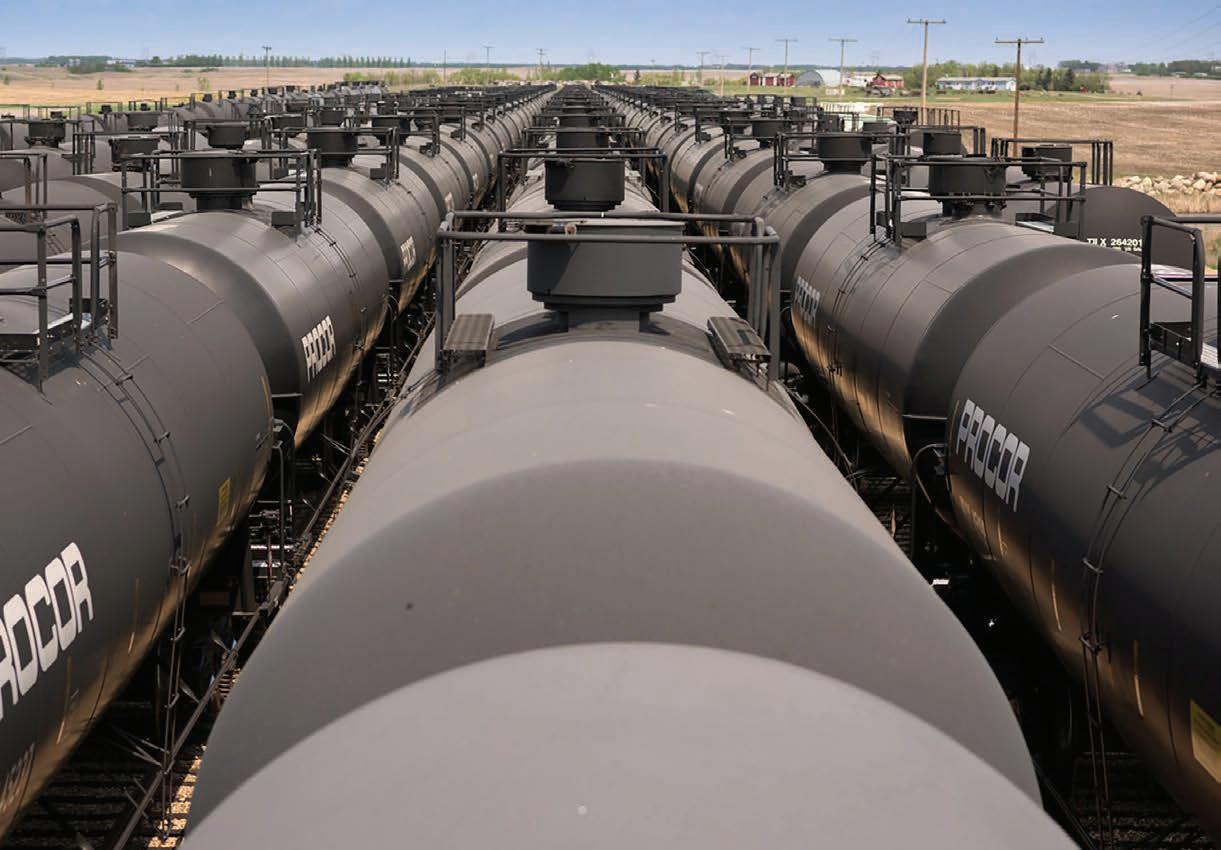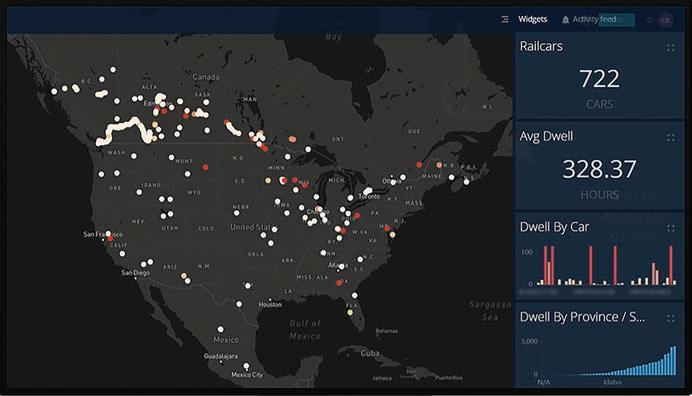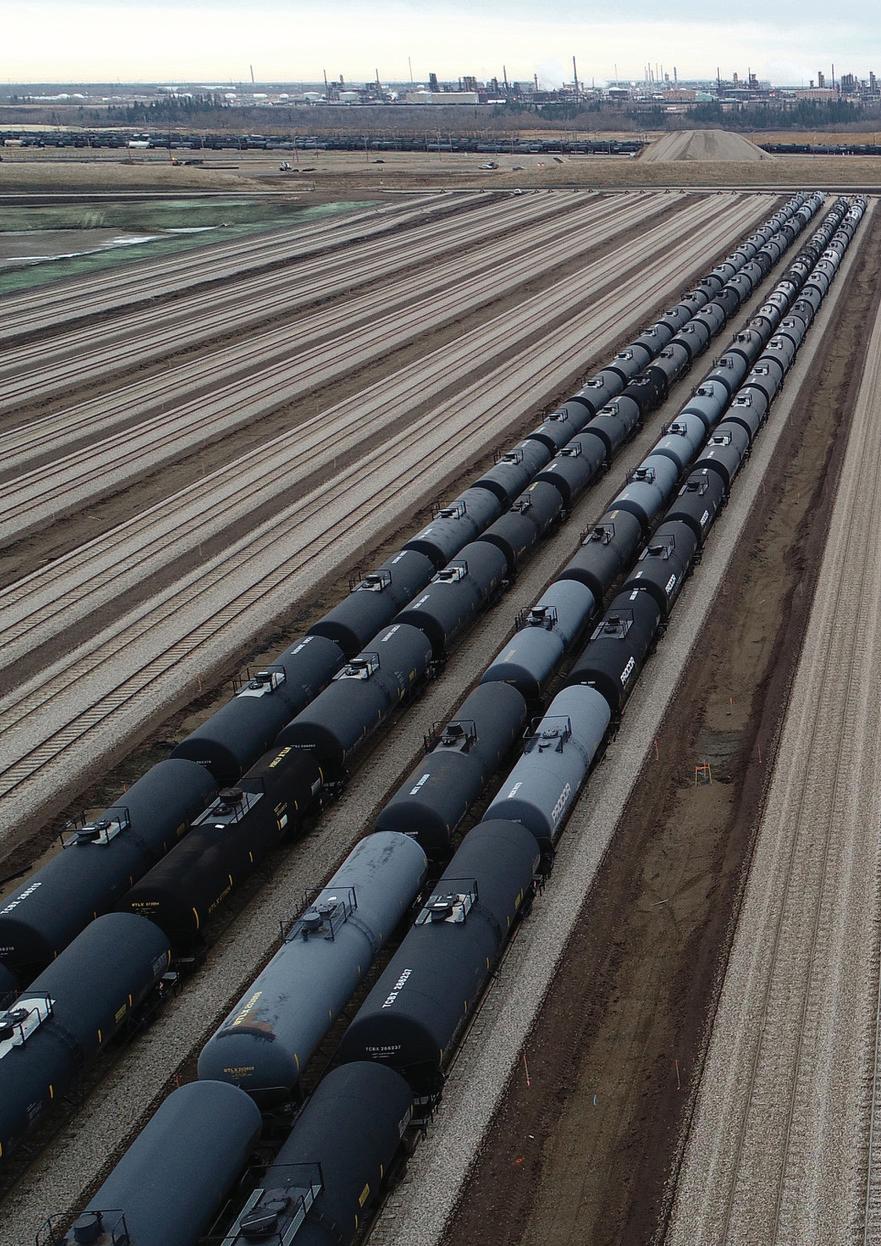
7 minute read
Staying On The Grid

STAYING

ON THE GRID
How better railcar visibility can improve freight rail shipment management.
BY BILL FAHRENWALD, JAMES STREET ASSOCIATES
When freight moves across North America’s major railroads, shippers need to know the location of their cargo and its status. Cars in motion frequently pass Automatic Equipment Identification (AEI) readers and other data collection devices. That information is instantaneously transmitted to rail industry systems and is available to railcar users in near real time.
Though this system works well for most shipments, it’s not perfect. In the real world, visibility can fade for a number of reasons, such as when cars are shunted into yards or industrial facilities, or when they are on “last/first-mile” short line railroads. In these locations, shipments can essentially drop off the grid, and shippers become more dependent on sporadic manually generated reports and cumbersome tracing methods.
These information gaps are frustrating for plant managers, retail operators and others who expect the seamless stream of location data that is now standard in the trucking industry. Most shippers depend on end-to-end supply chain visibility to manage inventory, staffing levels and storage allocation in a process that keeps costs low and customer satisfaction high.
RAIL FREIGHT VISIBILITY STILL HAS GAPS Intermittent visibility of rail shipments can diminish rail’s competitive advantages, which include low per-mile transportation costs, superior sustainability performance and an excellent safety record. Fortunately, advanced information technology systems are in the process of filling in the gaps, providing visibility that will be more competitive with highway shipping.
A leader in these developments is Cando Rail Services, based in Canada and serving all of North America. Last year, it launched Quasar, a cloud-based GPS system that tracks the location of railcars in real time, from origin to destination. Heading the development and launch of Quasar is Corrie Banks, Cando’s Director of Logistics. She joined Cando following a stellar rail industry career that began with development of e-commerce systems for a Class I railroad. That experience led her to managing complex supply chains. “Through those experiences,” she says, “I formulated a guiding principle that supply chain systems—which are highly interconnected end-to-end entities—offer lots and lots of opportunities to improve both the associated operating practices and the technology processes.”
AN IDEA BECOMES REALITY Eventually, Banks says, “I met Cando President and CEO Brian Cornick, and we started talking about some of the rail supply chain ideas and innovations he wanted to develop. At that time, I was also writing a white paper called Digital Supply Chains: Creating Skills for the Future for the Canadian Supply Chain Sector Council. All this led us to create a shared vision, which has resulted in today’s Quasar system.”
The Quasar platform is a set of technology tools that includes location sensors, geofencing, and network health and performance maps to create visual data. Functioning across the various applications, users access the visual data to create metrics and interact with predictive and prescriptive analytics. The entire system is designed to enable customers to get their goods to market at the lowest possible cost in the shortest possible time.
RUGGED TECHNOLOGY NEEDED It’s one thing to plan for improved railcar shipment visibility that looks good on paper, and quite another thing to implement it in the sometimes-brutal and often-isolated environment of the railroad network. Among the tools Quasar uses to close data gaps in remote locations are railcar-mounted GPS units.
“We know that railroad operating conditions can be unforgiving, which is why we vetted various products until we found units that are capable of supporting our commitment to provide car location data at least every 10 minutes. The units we selected have solar-powered batteries that have proven up to the task, and they are sufficiently rugged to operate without problems during the impacts of train operations,” says Banks.
Once Quasar developers had technology that met reliability requirements, they initiated a search for a single-source information technology partner that would feed data from the rail industry’s existing car location reporting network.
SELECTING THE RIGHT RAIL DATA PARTNER “Ultimately, we selected Railinc,” Banks says. “Not only were they able to provide the connection to industry data Quasar needs, but they also have been able to help us integrate that data seamlessly, and to make sure we were following the correct protocols and putting the right structures in place. It’s been very valuable for us.”
Quasar relies on Railinc as a sole source of critical visibility data including Umler®, railcar ownership information, industry reference files, messaging and more.
More than a year into real-world operations, Quasar users are starting to see the expected benefits. Shippers now have greatly improved visibility into what is arriving at their plants and distribution centers. This makes it possible to better plan production and distribution operations.
Once cars arrive at destination yards, Quasar provides complete yard management services including: • Switching. • Inventory status. • Railcar inspection management. • Railcar cleaning management. • Loaded or unloaded, and order status.
Managers can now easily see where all their rail equipment is located, its status, available capacity, and other parameters that were previously difficult to gather, or even unavailable.
The essential capability that makes this all possible is Quasar’s ability to digitize and blend information. “We take data from an amazing array of sources,” Banks says. “Quasar processes documents generated by supply chain participants including emails and PDFs. Using artificial intelligence, Quasar extracts relevant information and digitizes it.”
MAPPING, ANALYTICS OPEN NEW OPTIONS All of that data is then brought together and leveraged by geospatial intelligence and analytics capabilities provided, in part, by SensorUp. It collects, cleans and aggregates IoT (Internet of Things) data for analysis across all aspects and silos of an enterprise. SensorUp provides a level of granular insight—observed in real time— that enables managers to locate and direct railcars throughout North America.
After a car leaves a yard, for example, it might be some time before it passes an AEI reader. In the past, this has been one of the instances when shipment visibility could be temporarily lost. Quasar fills in those gaps with other information that documents the time the car departed the yard.
“Because Quasar is cloud-based, all this data is now presented in one central view, giving managers the story of what’s happening in their supply chains,” says Banks. “That view is literally presented on a map that shows the physical location of each car we are tracking.”
This information is automatically organized to display dwell- and cycle-time calculations, generated instantaneously as the data enters the system. The user can generate tools including heat maps with analytics that show which corridors


It’s one thing to plan for improved railcar shipment visibility that looks good on paper, and quite another thing to implement it in the sometimes-brutal and oftenisolated environment of the railroad network.
are faster or slower in real time, as well as analyzing transit time trends.
“If you are a plant manager and you need to know how your inventory will be flowing over the next couple of weeks, Quasar gives you a pretty good idea,” Banks says. “You can see in one view how things are shaping up.”
A BETTER SHIPPER/RAIL RELATIONSHIP Users are realizing an additional benefit from this wealth of real-time information. Now, instead of contacting a railroad’s customer service group for help in figuring out where a car is, or what is happening to it, they have that information right in front of them. This enables faster recognition of shipment exceptions, development of resolutions, and better communication with customers.
“There are benefits for our Class I partners, too,” Banks says. “They can reduce the amount of time and effort they are spending to mediate or manage issues. That can translate into better customer

Quasar GPS units on railcars provide seamless data.
service because the railroads can also act earlier to resolve railcar delays.”
As the aggregator of tracking data and developer of innovative visibility solutions for all North American railroads, including Class I’s, Railinc is integral to Quasar’s visibility. “Railinc’s role goes beyond the fact that they have a lot of the information we need to supplement IoT and other technologies,” Banks says. “We also have found them to be a very collaborative partner.”
In its overall operations, Cando provides services to both Class I railroads and shippers, and Railinc “provides strategic support, helping the company align with the industry’s overall digital transformation,” Banks says. “Railinc has the bench strength to serve as a key Quasar partner, and we’ve also been impressed with their dedication to providing comprehensive customer support. On a day-to-day basis as we deal with the customer service group, we have found they are incredibly helpful. We now rely on them for their deep industry knowledge and expertise. It’s a relationship that has been very beneficial to Cando and its customers, and it’s one we look forward to continuing.”







